|
Dec. 13, 2023
Stay informed! Here’s a summary of upcoming fisheries and habitat management activities and ways you can discover, explore and experience Minnesota’s outdoors.
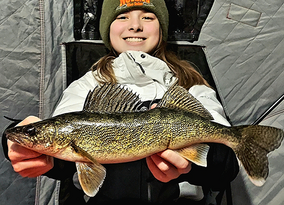
Learn to ice fish this season!
Ice fishing is a fun way to get out and enjoy winter in Minnesota! There’s nothing quite like traveling out on a frozen lake, drilling through the ice with an auger, scooping out the slush and getting some time to catch fish through the ice.
You might also be interested in spearing northern pike through the ice.
If you want to try ice fishing or expand your skills, the Minnesota DNR has a variety of helpful tips and how-to guides available for free. Check out our learn to ice fish webpages for general pointers and guides on how to catch a variety of fish species through the ice.
We also have an archive of outdoor skills and stewardship webinars that step through these skills. The archive includes webinars on ice fishing for panfish, northern pike, lake trout and lake sturgeon, and darkhouse spearing. Head to the DNR website and search for “ice fishing.”
The free webinars are part of the DNR’s Minnesota Outdoor Skills and Stewardship Series, which aims to give participants quick, relevant information on upcoming seasons and events, and skills to help enjoy these opportunities. Live webinars happen each Wednesday at noon, are free to join and registration is required.
For general information and fishing regulations, you’ll also want to visit the DNR fishing page.
“Hannah Garms, walleye night bite” photo courtesy of Jason Garms, February 2023
|
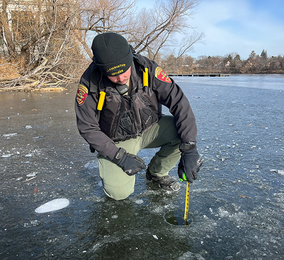
Take precautions on the ice
The ice season got off to a quick start in parts of Minnesota, with ice forming on some water bodies and numerous reports of ice anglers already testing their luck. But the weather over the last week has not been great for those who want to get out ice fishing. Many lakes that people have been out on likely have seen some degree of ice melting as a result of sun and warm weather.
If you choose to go on the ice, make sure to check ice thickness throughout the day. Don’t assume the path you walked onto the lake will be safe for your walk home. Ice melts faster near shore so don’t wait too long to return home if you think the ice is becoming unsafe. Now more than ever, it is crucial to wear a life jacket, ice picks, and ice cleats. And a cell phone, whistle or other communications device makes it more likely a person can call for help.
The Minnesota DNR reminds everyone to stay on shore until there’s at least 4 inches of new, clear ice. While 4 inches of new, clear ice is the minimum recommended thickness for walking, it takes at least 5 to 7 inches to hold a snowmobile or small all-terrain vehicle, 7 to 8 inches for a larger, side-by-side ATV, and 9 to 10 inches for a small car or SUV.
Each year, unexpected falls through thin ice lead to serious injury or death. Checking the ice thickness with a spud bar, auger or other device is the best way to prevent falling through. Wearing a life jacket is the best way to avert tragedy, since the initial shock of falling into cold water can incapacitate even strong swimmers. For more information, visit the DNR’s ice safety webpage.
|
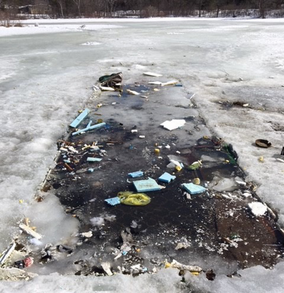
Keep the ice clean
Big changes are coming for all ice anglers this winter! A new law is in effect related to storing garbage and other waste (in all its forms) left on the ice. While the impetus for the law was increased dumping of sewage from permanent fish houses, it will affect all ice anglers, regardless of the type of shelter they use. Specifically, people using an ice shelter, vehicle or other conveyance on the ice may not deposit “garbage, rubbish, cigarette filters, debris from fireworks, offal, the body of a dead animal, litter, sewage or any other waste outside the shelter, motor vehicle or conveyance, unless the material is placed in a container that is secured to the shelter, motor vehicle or conveyance, and not placed directly on the ice or in state waters.”
The law is aimed at ensuring everyone who uses the ice can do so without encountering garbage and other substances that are not only a potential environmental concern, but an eyesore that takes away from a quality experience for winter recreationists of all kinds. During the winter, complaints about litter left on the ice are among the most common that DNR conservation officers receive.
They take these complaints seriously and work to locate violators. The penalty for a violation is a petty misdemeanor and carries a fine of $100.
Make a plan to store your garbage when you head out ice fishing. If you can’t store it inside your vehicle, bring colored garbage bags, a sturdy waste receptacle that won’t break in cold and the proper tools to secure them to your shelter, motor vehicle, snowmobile, trailer or other vehicles you drive out on the ice. Garbage and human/pet waste do not belong on the ice. Take off what you take on! Read the new statute online.
|

Winter regulations are in effect on Mille Lacs and Upper Red lakes
The walleye limit for Upper Red Lake is four this winter, an increase from the three allowed last winter. The Mille Lacs Lake walleye limit will remain at one.
Fall netting assessments on both lakes suggest these harvest levels will keep walleye populations sustainable and healthy.
Effective Nov. 1, anglers fishing on the state waters of Upper Red Lake can keep up to four walleye with one longer than 17 inches. As a reminder, this four-fish limit is both the daily and possession limit.
Beginning Dec. 1, Mille Lacs Lake anglers can keep one walleye 21-23 inches long or one longer than 28 inches.
The DNR sets winter regulations for these lakes after completion of annual fall population assessments. Results from Upper Red showed an optimal level of walleye spawning stock and a high overall net catch rate, especially of nearly mature walleye.
Mille Lacs’ results found slightly lower walleye numbers than in 2022. But the continued strong presence of walleye born in 2013 and 2017 and acceptable numbers of walleye born in 2021 and 2022 suggest there are adequate numbers of younger fish to keep the population sustainable as they mature and reproduce to replace fish caught by anglers.
Complete winter fishing regulations are available on the Upper Red Lake regulations webpage and the Mille Lacs Lake regulations webpage.
Especially in regards to Upper Red, we get questions how to handle fish cooked in a fish house and the requirement to retain carcasses, and how this applies to possession limits. For this information, please read the details on pages 32-33 in the Minnesota Fishing regulations.
Photo courtesy of Erik Jorgensen on Mille Lacs Lake during Take a Kid Fishing Weekend, January 2023
|
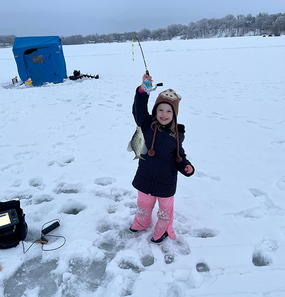
Give the gift of outdoor opportunities
For those hunting for holiday gift ideas, consider giving someone the opportunity for a lifetime of outdoor adventures with a Minnesota lifetime fishing or hunting license. The memory of time spent outdoors is one of the most meaningful gifts one can give.
The Minnesota DNR offers reduced rates for those under age 16 and over 50. Plus, if license prices increase or the license holder moves out of state, lifetime licenses remain valid.
People can buy a license for themselves, or as a gift for someone else. More information is available on the DNR website about licenses for Minnesota residents and non-residents.
“Crappie time” photo courtesy of Johnathan Molencamp, December 2022
|
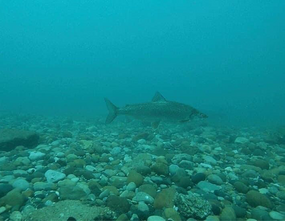
Fish highlight: lake whitefish
The lake whitefish ranks among some of the best-tasting freshwater fish
With a mild flavor and medium-firm flaky white meat, these fish are ideal for smoking, grilling, baking, or frying. Lake whitefish are native to icy northern waters and live deep within Lake Superior. They can also be found in deep, cool-water lakes of northern Minnesota, including within the Boundary Waters Canoe Area Wilderness.
Spawning begins when shallow water temperatures dip below 45 degrees in the fall. Spawning typically lasts from late-October to mid-December.
In the winter, lake whitefish may swim right under the ice. You can target them while ice fishing using a small jigging spoon and minnow. Check out our recorded webinar “Ciscos: Minnesota lakes' keystone fish species.”
Photo courtesy of iNaturalist
|
Send us your fishing photos
Anglers, we’d love to see your fishing photos! Here are a few of the memories captured in the last year or two. Photos submitted are used in Minnesota DNR publications including social media, newsletters, news releases, webpages and more. You could be featured on the cover of the 2024 fishing regulations. Upload your photos online!
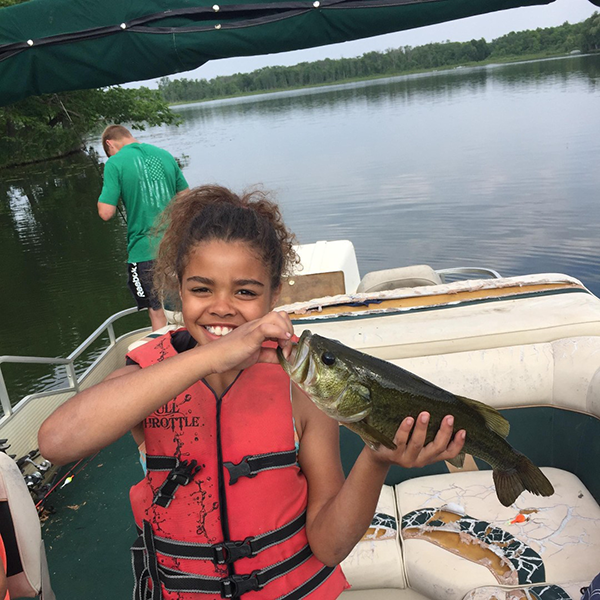 “Fishing with Papa” photo courtesy of Nana Nelson, June 2023
 “Large perch caught on Lake Superior” courtesy of Evan, January 2023
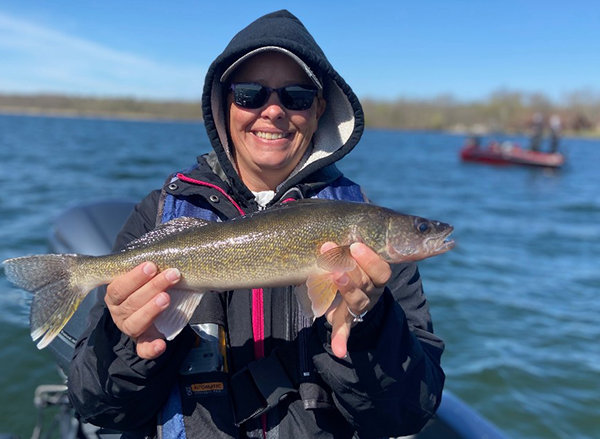 “Leech Lake walleye” photo courtesy of Jim Stoeckel, May 2023
 “16 3/4 inch crappie” photo courtesy of Josh, May 2022
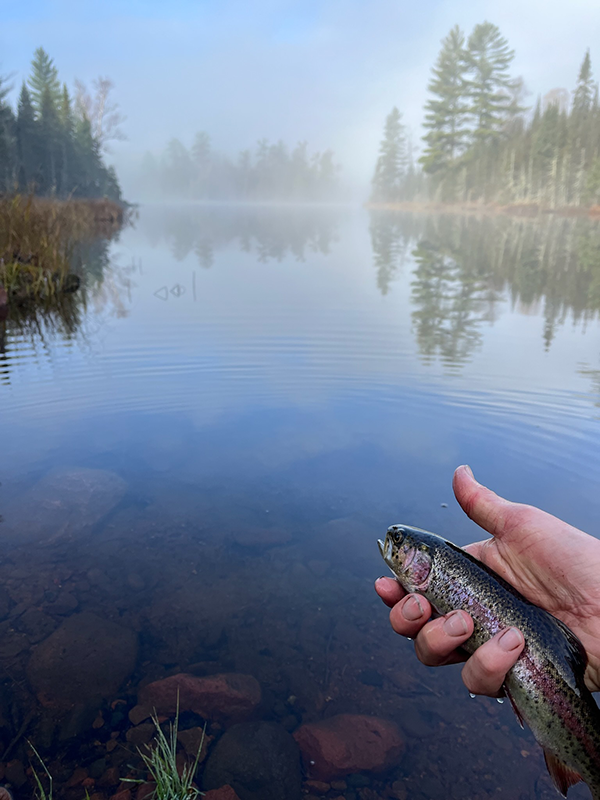 “Foggy morning, rainbow trout in Superior National Forest” photo courtesy of Patrick Gaffney, October 2023
|